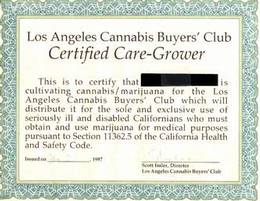 
USA ヘンプ・ミュージアム
 館長から皆さまへ
館長から皆さまへ ヘンプの歴史
ヘンプの歴史 ヘンプと農業
ヘンプと農業  ヘンプの医療と健康
ヘンプの医療と健康 ヘンプと医療
ヘンプと医療 ヘンプ医療の小史
ヘンプ医療の小史 ヘンプの安全性
ヘンプの安全性 医療ヘンプ・キャンペーン
医療ヘンプ・キャンペーン ヘンプと緊急医療
ヘンプと緊急医療 ヘンプと健康
ヘンプと健康 医療ヘンプ条例
医療ヘンプ条例 医療ヘンプ・レシピ
医療ヘンプ・レシピ 書簡
書簡 ヘンプ医薬品関連リスト
ヘンプ医薬品関連リスト 医療ヘンプ関連図書
医療ヘンプ関連図書 Video/Right to Smile
Video/Right to Smile Video/Medical Marijuane Protest
Video/Medical Marijuane Protest ヘンプ食品
ヘンプ食品 ヘンプ織物
ヘンプ織物 ヘンプ縄と糸
ヘンプ縄と糸 ヘンプパルプ紙
ヘンプパルプ紙 ヘンプ建材
ヘンプ建材 ヘンプ燃料
ヘンプ燃料 ヘンプ原料
ヘンプ原料 ヘンプ溶剤
ヘンプ溶剤 ヘンプ・プラスチック
ヘンプ・プラスチック ヘンプと環境
ヘンプと環境 ヘンプと娯楽と精神世界
ヘンプと娯楽と精神世界 ヘンプと法律
ヘンプと法律 ヘンプと政治
ヘンプと政治 ヘンプ貢献者
ヘンプ貢献者 ミュージアム図書館
ミュージアム図書館 Topに戻る
Topに戻る |
|
The people of California passed Proposition 215 in November of 1996, authorizing in law the use of Cannabis sativa [marijuana] for medical purposes ( CA Health & Safety Code 11362.5). Two years later despite one purpose of the act being, "to encourage state and federal governments to implement a plan to provide for the safe and affordable distribution of marijuana to all patients in medical need of marijuana," governments have failed to act. In the recent general elections (1998), five more states have passed laws allowing the use of the plant Cannabis sativa [marijuana] as medicine using various criteria. They will be joining the struggle to get Cannabis to needy patients. The purpose of this packet is to provide some information, guidance, forms, and supporting information for using legal marijuana in the void left by the inaction of governments. Section 11362.5, CA Health & Safety Code was added to law by the CA initiative process by the people of California. Below is that complete code addition: California Health and Safety Code I.This section shall be known as the Compassionate Use Act of 1996. II. The people to the State of California hereby find and declare that the purposes of the Compassionate Use Act of 1996 are as follows: (A) To ensure that seriously ill Californians have the right to obtain and use marijuana for medical purposes where that medical use is deemed appropriate and has been recommended by a physician who has determined that the person's health would benefit from the use of marijuana in the treatment of cancer, anorexia, AIDS, chronic pain, spasticity, glaucoma, arthritis, migraine, or any other illness for which marijuana provides relief.Nothing in this section shall be construed to supersede legislation from engaging in conduct that endangers others, nor to condone the diversion of marijuana for nonmedical purposes. III. Notwithstanding any other provision of law, no physician in this state shall be punished or denied any right or privilege, for having recommended marijuana to a patient for medical purposes. IV. Section 11357, relating to the possession of marijuana and Section 11358, relating to the cultivation of marijuana, shall not apply to a patient, or to a patient's primary caregiver, who possesses or cultivates marijuana for the personal medical purposes of the patient upon the written or oral recommendation or approval of a physician. V. For the purposes of this section, "primary caregiver" means the individual designated by the person exempted under this section who has consistently assumed responsibility for the housing, health, or safety of that person. (end) ***** ***** ***** For both doctors and patients it might be helpful to attempt to answer the question why try Cannabis [marijuana] for any ailment? I will attempt to answer the question in three parts, dealing with history, safety, and efficacy (does it work).A. SAFETY: Francis L. Young, Admin. Law Judge, D.E.A. Docket # 86-22, 1988. In 1980, a culmination of 8 years of lawsuits by National Organization for the Reform of Marijuana Laws (NORML), led the United States Court of Appeals, D.C. Circuit to direct the Drug Enforcement Administration to hold hearing on the rescheduling of marijuana to allow its use as medicine. For six years this process drug on and in 1986 the DEA requested their own Judge Francis L. Young to commence these hearings which lasted two years.In addition to hearing arguments on the proposed rescheduling of marijuana, it was agreed he would determine: "Whether there is a lack of accepted safety for use of the marijuana plant under medical supervision." His report on safety "shows the following facts to be uncontroverted (unchallenged)." Excerpts from the record include: 3. The most obvious concern when dealing with drug safety is the possibility of lethal effects. Can the drug cause death? B. EFFICACY: "In determining whether a medical procedure utilized by a doctor is actionable as malpractice the courts have adopted the rule that it is acceptable for a doctor to employ a method of treatment supported by a respectable minority of physicians...A respectable minority of physicians have accepted marijuana as having a medical use in treatment in the United States...for nausea and vomiting resulting from chemotherapy treatments in some cancer patients...for spasticity resulting from multiple sclerosis and other causes." (DEA Docket #86-22). C. HISTORY:
|

